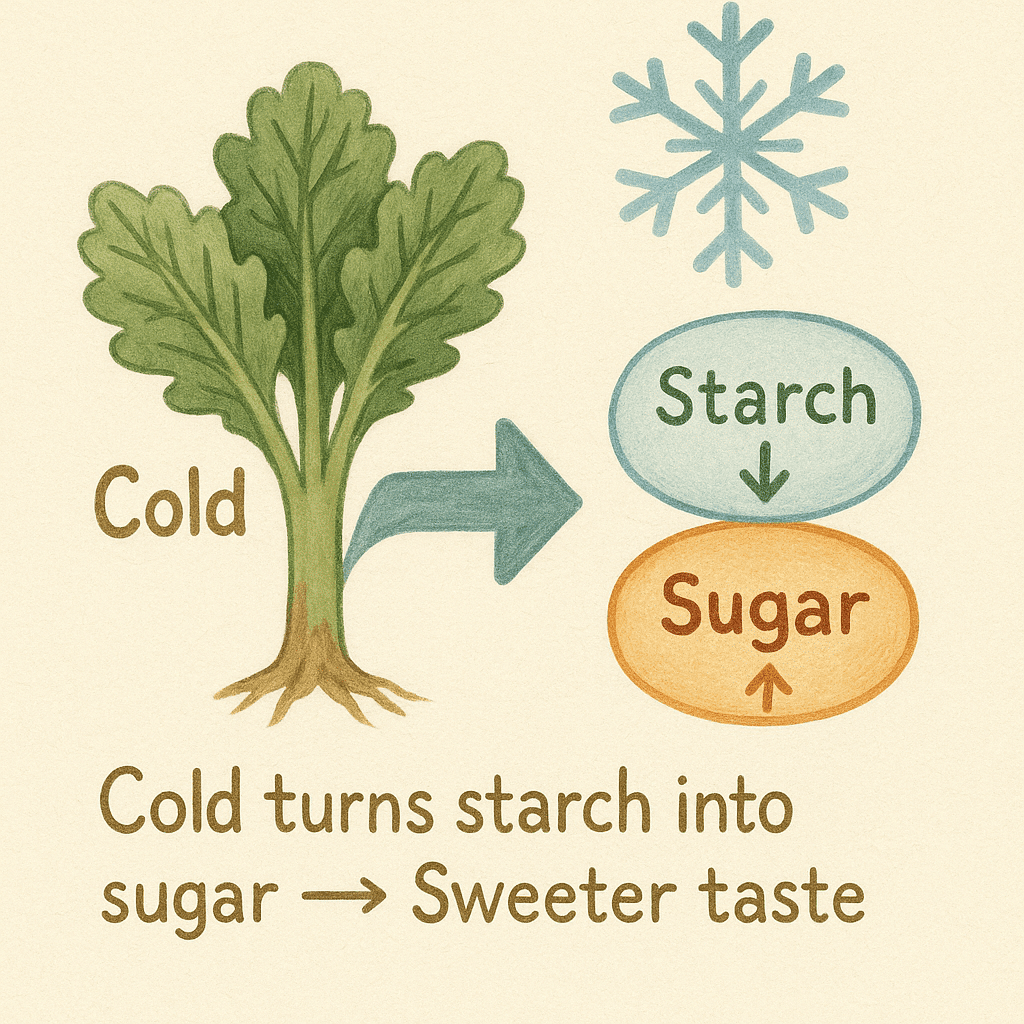When temperatures start to drop and most gardens seem to fade away, many gardeners assume the growing season has come to an end. But here’s the good news: some vegetables actually love the cold and a few even taste better after a touch of frost.
In this article, we’ll explore the best cold-weather vegetables to grow, how to protect them from frost, and the one surprising veggie that keeps thriving even under snow.
I’ve also made a video where I show you exactly how to grow vegetables that thrive in cold weather. It’s full of simple, practical tips you can use to keep your garden productive all winter long.
🥬 Kale — The Winter Champion
Few plants are as resilient as kale.
Not only does it tolerate cold weather — it thrives in it. When temperatures dip below freezing, kale naturally converts its starches into sugars as a form of protection.
The result? Sweeter, more flavorful leaves that make delicious winter salads or soups.
To grow kale successfully:
- Keep the soil consistently moist but not soggy.
- Harvest the outer leaves regularly to encourage new growth from the center.
- Mulch around the base to insulate the roots.
Why it’s great for winter: Kale can survive frost, snow, and even light freezes — a perfect pick for hardy gardeners.

🥕 Carrots — Sweetness in the Cold
Carrots are another cold-hardy favorite. In fact, their flavor improves with frost. The cold triggers a chemical process that increases their sugar content, making them extra sweet and crunchy.
To protect your carrots through winter:
- Leave them in the ground as long as possible.
- Cover the tops with straw or mulch to prevent the soil from freezing solid.
- Harvest gradually, pulling up only what you need.
Your garden becomes a natural refrigerator, keeping your carrots fresh right in the soil until early winter or beyond.

🧅 Onions and Garlic — The Patient Growers
Onions and garlic prefer cool conditions and are perfect for fall planting.
When planted before the ground freezes, they spend the winter months developing strong root systems, then burst into growth once spring arrives.
Tips for success:
- Choose well-draining soil to prevent rot.
- Plant bulbs or sets 2–4 weeks before the first hard frost.
- Mulch heavily to protect against extreme temperature drops.
These crops may take their time, but the reward is worth it — low-maintenance, high-yielding, and long-lasting.
🥦 Broccoli and Cabbage — The Cold-Weather Workhorses
Members of the brassica family (including broccoli, cabbage, and cauliflower) are classic winter vegetables.
They can handle temperatures just above freezing and even continue growing under light frost if given a bit of protection.
How to keep them thriving:
- Start seeds in late summer or early autumn.
- Cover with a garden fleece or cloche to shield from severe frost.
- Harvest regularly to promote continuous growth.
Even when the rest of your garden lies dormant, these leafy giants quietly keep producing nutritious, hardy greens.
🌿 Spinach — The Bridge Crop
Few vegetables bridge the seasons as gracefully as spinach.
It’s a cold-loving green that grows slowly but steadily through winter, even with shorter daylight hours.
To get the best results:
- Choose hardy varieties like ‘Winter Giant’ or ‘Bloomsdale Long Standing’.
- Cover lightly at night to protect from deep frost.
- Harvest outer leaves to allow inner ones to regrow.
Because it keeps producing well into early spring, spinach truly is a “bridge crop” — carrying your garden from fall into the new growing season.
Leeks — Standing Tall in the Snow
Leeks are built for cold climates and can easily withstand frost and snow once established.
Plant them in summer, and by winter, you’ll have sturdy, tall stems that store exceptionally well right in the soil.
Tips for growing leeks:
- Hill up soil around the stems to encourage long, white shafts.
- Water consistently through summer for steady growth.
- Harvest as needed — leeks can stay in the ground until spring without losing quality.
Leeks are proof that some vegetables don’t just survive winter — they thrive in it.
❄️ Bonus: The Vegetable That Grows Under Snow — Parsnips
If one vegetable truly shines under frost, it’s the parsnip.
Like carrots, parsnips become sweeter and more flavorful after the first freeze. The cold transforms their starches into natural sugars, giving them a rich, nutty, earthy taste that’s perfect for roasting or soups.
Simply:
- Leave them in the ground after frost.
- Harvest once the soil softens — even under snow if you’re adventurous!
Parsnips prove that sometimes, nature improves flavor when the weather turns cold.
So, to recap — the best cold-weather vegetables to grow include:
- Kale and spinach,
- Carrots and parsnips,
- Onions, garlic, and leeks,
- Broccoli and cabbage.
With a little planning and protection — like mulching, cold frames, or garden fleece — these crops will keep your garden productive all winter long.
Cold weather doesn’t mean the end of your harvest — it’s simply a different kind of growing season.
So bundle up, grab your gardening gloves, and keep growing — even when the world outside turns frosty.

